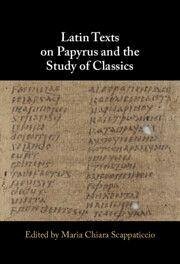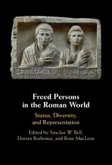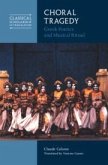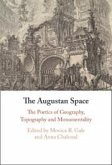Latin Texts on Papyrus and the Study of Classics
Herausgeber: Scappaticcio, Maria Chiara
Latin Texts on Papyrus and the Study of Classics
Herausgeber: Scappaticcio, Maria Chiara
- Gebundenes Buch
- Merkliste
- Auf die Merkliste
- Bewerten Bewerten
- Teilen
- Produkt teilen
- Produkterinnerung
- Produkterinnerung
This volume gathers 25 chapters focused on Latin texts on papyrus, exploring them from multi- and cross-disciplinary perspectives. It serves as a companion to the texts published in The Corpus of Latin Texts on Papyrus (Cambridge, forthcoming). The chapters provide in-depth analyses of the chosen texts from literary, philological, linguistic, and historical perspectives, or offer methodological reflections on Latin texts on papyrus, promoting innovative approaches. They cover topics ranging from palaeography and philology to Latin literature and from ancient law to ancient and medieval…mehr
Andere Kunden interessierten sich auch für
![Freed Persons in the Roman World Freed Persons in the Roman World]() Freed Persons in the Roman World98,99 €
Freed Persons in the Roman World98,99 €![Choral Tragedy Choral Tragedy]() Claude CalameChoral Tragedy98,99 €
Claude CalameChoral Tragedy98,99 €![The Augustan Space The Augustan Space]() The Augustan Space98,99 €
The Augustan Space98,99 €![Sappho and Homer Sappho and Homer]() Melissa MuellerSappho and Homer98,99 €
Melissa MuellerSappho and Homer98,99 €![Cultural Memory in Republican and Augustan Rome Cultural Memory in Republican and Augustan Rome]() Cultural Memory in Republican and Augustan Rome134,99 €
Cultural Memory in Republican and Augustan Rome134,99 €![Connecting Communities in Archaic Greece Connecting Communities in Archaic Greece]() Michael LoyConnecting Communities in Archaic Greece116,99 €
Michael LoyConnecting Communities in Archaic Greece116,99 €![Greek Translations of Roman Gods Greek Translations of Roman Gods]() Bradley BuszardGreek Translations of Roman Gods82,99 €
Bradley BuszardGreek Translations of Roman Gods82,99 €-
-
-
This volume gathers 25 chapters focused on Latin texts on papyrus, exploring them from multi- and cross-disciplinary perspectives. It serves as a companion to the texts published in The Corpus of Latin Texts on Papyrus (Cambridge, forthcoming). The chapters provide in-depth analyses of the chosen texts from literary, philological, linguistic, and historical perspectives, or offer methodological reflections on Latin texts on papyrus, promoting innovative approaches. They cover topics ranging from palaeography and philology to Latin literature and from ancient law to ancient and medieval history, and brilliantly demonstrate the potential of Latin texts on papyrus to inspire and illuminate the field of Classics.
Produktdetails
- Produktdetails
- Verlag: Cambridge University Press
- Seitenzahl: 450
- Erscheinungstermin: 31. Januar 2026
- Englisch
- ISBN-13: 9781009586597
- ISBN-10: 1009586599
- Artikelnr.: 73731729
- Herstellerkennzeichnung
- Libri GmbH
- Europaallee 1
- 36244 Bad Hersfeld
- gpsr@libri.de
- Verlag: Cambridge University Press
- Seitenzahl: 450
- Erscheinungstermin: 31. Januar 2026
- Englisch
- ISBN-13: 9781009586597
- ISBN-10: 1009586599
- Artikelnr.: 73731729
- Herstellerkennzeichnung
- Libri GmbH
- Europaallee 1
- 36244 Bad Hersfeld
- gpsr@libri.de
Latin Texts on Papyrus: A Project, Its Corpus, and the Future of Research.
I. The Literary Perspective, II. The Documentary Perspective M. C.
Scappaticcio and L. C. Colella; Part I. Philological and Literary Insights:
1. The papyri of Terence and the Latin grammatical tradition F. Biville; 2.
Latin gnomic literature in light of P. Mich. VII 430 (= CLTP IB.20) A. S.
Gitner; 3. Medical or culinary recipes? On the technical prose of a
first-century roll A. Garcea; 4. P. Hamb. II 167 recto: drama (in prose?)
C. Panayotakis; 5. The Latin papyri from the Herculaneum library: new
results and fresh perspectives T. Dorandi; 6. Editing the Carmen de Bello
Aegyptiaco for the CLTP: new results and further perspectives V. Piano; 7.
Virgilian Centos and Papyri Vergilianae P. Paolucci; 8. 'Varus, give me
back my ... money!' Marginal notes on the Hadrianus S. Rocchi; Part II.
Philological and Linguistic Insights: 9. From Roman Egypt to the
Renaissance: the evolution of the Celtis glossary (part 1) E. Dickey;
10. From Roman Egypt to the Renaissance: the evolution of the Celtis
glossary (part 2) R. Ferri; 11. Latin in Roman soldiers' and veterans'
private documents: selected case studies A. Pezzella; 12. The relevance of
the Italian papyri to the study of late Latin and the emergence of the
Romance vernaculars R. Sornicola; 13. On the Latin-Arabic bilingual
papyrus, British Library inv. 3124: the 'Italian' connection G. D'Alessio;
14. Allography in Latin ostraca (Assenamat, Gigthi, Bu Njem): linguistic
analysis of Paleo-Amazigh personal names and external implications A.
Bernini; 15. Latin ostraca from Tripolitania C. Múrcia Sanchez; Part III.
Palaeographic Insights: 16. The Latin papyri and the history of writing, or
about their contribution to the formation of a scientific vocabulary in
palaeography T. De Robertis; 17. Some reflections on the presence of
accents in the Montserrat Cicero's in Catilinam ii A. Nodar; 18. A Survey
on abbreviating (and punctuation) signs in Latin documentary papyri,
ostraka and tablets from Roman Africa and the East (BCE I-VII CE) G.
Iovine; 19. Rethinking the evidence for Latin shorthand in Late Antiquity
and the Early Middle Ages A. Ghignoli; Part IV. Juridical and Historical
Insights: 20. Ancient jurists and Latin papyri F. Nasti; 21. The
contribution of the CLTP to the study of Roman justice M. Pedone; 22.
Julio-Claudian procedural reforms and imperial constitutions in the light
of BGU II 611 and BGU II 628 P. Buongiorno; 23. Marcus Aper and the ala
Apriana L. Capponi; 24. Did a fiscus barbaricus ever exist? Remarks on
P.Ital. 1 (AD 445-446) D. Internullo.
I. The Literary Perspective, II. The Documentary Perspective M. C.
Scappaticcio and L. C. Colella; Part I. Philological and Literary Insights:
1. The papyri of Terence and the Latin grammatical tradition F. Biville; 2.
Latin gnomic literature in light of P. Mich. VII 430 (= CLTP IB.20) A. S.
Gitner; 3. Medical or culinary recipes? On the technical prose of a
first-century roll A. Garcea; 4. P. Hamb. II 167 recto: drama (in prose?)
C. Panayotakis; 5. The Latin papyri from the Herculaneum library: new
results and fresh perspectives T. Dorandi; 6. Editing the Carmen de Bello
Aegyptiaco for the CLTP: new results and further perspectives V. Piano; 7.
Virgilian Centos and Papyri Vergilianae P. Paolucci; 8. 'Varus, give me
back my ... money!' Marginal notes on the Hadrianus S. Rocchi; Part II.
Philological and Linguistic Insights: 9. From Roman Egypt to the
Renaissance: the evolution of the Celtis glossary (part 1) E. Dickey;
10. From Roman Egypt to the Renaissance: the evolution of the Celtis
glossary (part 2) R. Ferri; 11. Latin in Roman soldiers' and veterans'
private documents: selected case studies A. Pezzella; 12. The relevance of
the Italian papyri to the study of late Latin and the emergence of the
Romance vernaculars R. Sornicola; 13. On the Latin-Arabic bilingual
papyrus, British Library inv. 3124: the 'Italian' connection G. D'Alessio;
14. Allography in Latin ostraca (Assenamat, Gigthi, Bu Njem): linguistic
analysis of Paleo-Amazigh personal names and external implications A.
Bernini; 15. Latin ostraca from Tripolitania C. Múrcia Sanchez; Part III.
Palaeographic Insights: 16. The Latin papyri and the history of writing, or
about their contribution to the formation of a scientific vocabulary in
palaeography T. De Robertis; 17. Some reflections on the presence of
accents in the Montserrat Cicero's in Catilinam ii A. Nodar; 18. A Survey
on abbreviating (and punctuation) signs in Latin documentary papyri,
ostraka and tablets from Roman Africa and the East (BCE I-VII CE) G.
Iovine; 19. Rethinking the evidence for Latin shorthand in Late Antiquity
and the Early Middle Ages A. Ghignoli; Part IV. Juridical and Historical
Insights: 20. Ancient jurists and Latin papyri F. Nasti; 21. The
contribution of the CLTP to the study of Roman justice M. Pedone; 22.
Julio-Claudian procedural reforms and imperial constitutions in the light
of BGU II 611 and BGU II 628 P. Buongiorno; 23. Marcus Aper and the ala
Apriana L. Capponi; 24. Did a fiscus barbaricus ever exist? Remarks on
P.Ital. 1 (AD 445-446) D. Internullo.
Latin Texts on Papyrus: A Project, Its Corpus, and the Future of Research.
I. The Literary Perspective, II. The Documentary Perspective M. C.
Scappaticcio and L. C. Colella; Part I. Philological and Literary Insights:
1. The papyri of Terence and the Latin grammatical tradition F. Biville; 2.
Latin gnomic literature in light of P. Mich. VII 430 (= CLTP IB.20) A. S.
Gitner; 3. Medical or culinary recipes? On the technical prose of a
first-century roll A. Garcea; 4. P. Hamb. II 167 recto: drama (in prose?)
C. Panayotakis; 5. The Latin papyri from the Herculaneum library: new
results and fresh perspectives T. Dorandi; 6. Editing the Carmen de Bello
Aegyptiaco for the CLTP: new results and further perspectives V. Piano; 7.
Virgilian Centos and Papyri Vergilianae P. Paolucci; 8. 'Varus, give me
back my ... money!' Marginal notes on the Hadrianus S. Rocchi; Part II.
Philological and Linguistic Insights: 9. From Roman Egypt to the
Renaissance: the evolution of the Celtis glossary (part 1) E. Dickey;
10. From Roman Egypt to the Renaissance: the evolution of the Celtis
glossary (part 2) R. Ferri; 11. Latin in Roman soldiers' and veterans'
private documents: selected case studies A. Pezzella; 12. The relevance of
the Italian papyri to the study of late Latin and the emergence of the
Romance vernaculars R. Sornicola; 13. On the Latin-Arabic bilingual
papyrus, British Library inv. 3124: the 'Italian' connection G. D'Alessio;
14. Allography in Latin ostraca (Assenamat, Gigthi, Bu Njem): linguistic
analysis of Paleo-Amazigh personal names and external implications A.
Bernini; 15. Latin ostraca from Tripolitania C. Múrcia Sanchez; Part III.
Palaeographic Insights: 16. The Latin papyri and the history of writing, or
about their contribution to the formation of a scientific vocabulary in
palaeography T. De Robertis; 17. Some reflections on the presence of
accents in the Montserrat Cicero's in Catilinam ii A. Nodar; 18. A Survey
on abbreviating (and punctuation) signs in Latin documentary papyri,
ostraka and tablets from Roman Africa and the East (BCE I-VII CE) G.
Iovine; 19. Rethinking the evidence for Latin shorthand in Late Antiquity
and the Early Middle Ages A. Ghignoli; Part IV. Juridical and Historical
Insights: 20. Ancient jurists and Latin papyri F. Nasti; 21. The
contribution of the CLTP to the study of Roman justice M. Pedone; 22.
Julio-Claudian procedural reforms and imperial constitutions in the light
of BGU II 611 and BGU II 628 P. Buongiorno; 23. Marcus Aper and the ala
Apriana L. Capponi; 24. Did a fiscus barbaricus ever exist? Remarks on
P.Ital. 1 (AD 445-446) D. Internullo.
I. The Literary Perspective, II. The Documentary Perspective M. C.
Scappaticcio and L. C. Colella; Part I. Philological and Literary Insights:
1. The papyri of Terence and the Latin grammatical tradition F. Biville; 2.
Latin gnomic literature in light of P. Mich. VII 430 (= CLTP IB.20) A. S.
Gitner; 3. Medical or culinary recipes? On the technical prose of a
first-century roll A. Garcea; 4. P. Hamb. II 167 recto: drama (in prose?)
C. Panayotakis; 5. The Latin papyri from the Herculaneum library: new
results and fresh perspectives T. Dorandi; 6. Editing the Carmen de Bello
Aegyptiaco for the CLTP: new results and further perspectives V. Piano; 7.
Virgilian Centos and Papyri Vergilianae P. Paolucci; 8. 'Varus, give me
back my ... money!' Marginal notes on the Hadrianus S. Rocchi; Part II.
Philological and Linguistic Insights: 9. From Roman Egypt to the
Renaissance: the evolution of the Celtis glossary (part 1) E. Dickey;
10. From Roman Egypt to the Renaissance: the evolution of the Celtis
glossary (part 2) R. Ferri; 11. Latin in Roman soldiers' and veterans'
private documents: selected case studies A. Pezzella; 12. The relevance of
the Italian papyri to the study of late Latin and the emergence of the
Romance vernaculars R. Sornicola; 13. On the Latin-Arabic bilingual
papyrus, British Library inv. 3124: the 'Italian' connection G. D'Alessio;
14. Allography in Latin ostraca (Assenamat, Gigthi, Bu Njem): linguistic
analysis of Paleo-Amazigh personal names and external implications A.
Bernini; 15. Latin ostraca from Tripolitania C. Múrcia Sanchez; Part III.
Palaeographic Insights: 16. The Latin papyri and the history of writing, or
about their contribution to the formation of a scientific vocabulary in
palaeography T. De Robertis; 17. Some reflections on the presence of
accents in the Montserrat Cicero's in Catilinam ii A. Nodar; 18. A Survey
on abbreviating (and punctuation) signs in Latin documentary papyri,
ostraka and tablets from Roman Africa and the East (BCE I-VII CE) G.
Iovine; 19. Rethinking the evidence for Latin shorthand in Late Antiquity
and the Early Middle Ages A. Ghignoli; Part IV. Juridical and Historical
Insights: 20. Ancient jurists and Latin papyri F. Nasti; 21. The
contribution of the CLTP to the study of Roman justice M. Pedone; 22.
Julio-Claudian procedural reforms and imperial constitutions in the light
of BGU II 611 and BGU II 628 P. Buongiorno; 23. Marcus Aper and the ala
Apriana L. Capponi; 24. Did a fiscus barbaricus ever exist? Remarks on
P.Ital. 1 (AD 445-446) D. Internullo.








